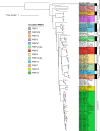The genome and transcriptome of the snail Biomphalaria sudanica s.l.: immune gene diversification and highly polymorphic genomic regions in an important African vector of Schistosoma mansoni
- PMID: 38373909
- PMCID: PMC10875847
- DOI: 10.1186/s12864-024-10103-w
The genome and transcriptome of the snail Biomphalaria sudanica s.l.: immune gene diversification and highly polymorphic genomic regions in an important African vector of Schistosoma mansoni
Abstract
Background: Control and elimination of schistosomiasis is an arduous task, with current strategies proving inadequate to break transmission. Exploration of genetic approaches to interrupt Schistosoma mansoni transmission, the causative agent for human intestinal schistosomiasis in sub-Saharan Africa and South America, has led to genomic research of the snail vector hosts of the genus Biomphalaria. Few complete genomic resources exist, with African Biomphalaria species being particularly underrepresented despite this being where the majority of S. mansoni infections occur. Here we generate and annotate the first genome assembly of Biomphalaria sudanica sensu lato, a species responsible for S. mansoni transmission in lake and marsh habitats of the African Rift Valley. Supported by whole-genome diversity data among five inbred lines, we describe orthologs of immune-relevant gene regions in the South American vector B. glabrata and present a bioinformatic pipeline to identify candidate novel pathogen recognition receptors (PRRs).
Results: De novo genome and transcriptome assembly of inbred B. sudanica originating from the shoreline of Lake Victoria (Kisumu, Kenya) resulted in a haploid genome size of ~ 944.2 Mb (6,728 fragments, N50 = 1.067 Mb), comprising 23,598 genes (BUSCO = 93.6% complete). The B. sudanica genome contains orthologues to all described immune genes/regions tied to protection against S. mansoni in B. glabrata, including the polymorphic transmembrane clusters (PTC1 and PTC2), RADres, and other loci. The B. sudanica PTC2 candidate immune genomic region contained many PRR-like genes across a much wider genomic region than has been shown in B. glabrata, as well as a large inversion between species. High levels of intra-species nucleotide diversity were seen in PTC2, as well as in regions linked to PTC1 and RADres orthologues. Immune related and putative PRR gene families were significantly over-represented in the sub-set of B. sudanica genes determined as hyperdiverse, including high extracellular diversity in transmembrane genes, which could be under pathogen-mediated balancing selection. However, no overall expansion in immunity related genes was seen in African compared to South American lineages.
Conclusions: The B. sudanica genome and analyses presented here will facilitate future research in vector immune defense mechanisms against pathogens. This genomic/transcriptomic resource provides necessary data for the future development of molecular snail vector control/surveillance tools, facilitating schistosome transmission interruption mechanisms in Africa.
Keywords: Balancing selection; Biomphalaria choanomphala; Biomphalaria sudanica; De novo genome assembly; Gene family evolution; Immunogenetics; Pathogen recognition; Polymorphism; Schistosomiasis; Snail vector.
© 2024. The Author(s).
Conflict of interest statement
Not applicable.
Figures










Update of
-
The genome and transcriptome of the snail Biomphalaria sudanica s.l.: Immune gene diversification and highly polymorphic genomic regions in an important African vector of Schistosoma mansoni.bioRxiv [Preprint]. 2023 Nov 2:2023.11.01.565203. doi: 10.1101/2023.11.01.565203. bioRxiv. 2023. Update in: BMC Genomics. 2024 Feb 19;25(1):192. doi: 10.1186/s12864-024-10103-w. PMID: 37961413 Free PMC article. Updated. Preprint.
Similar articles
-
The genome and transcriptome of the snail Biomphalaria sudanica s.l.: Immune gene diversification and highly polymorphic genomic regions in an important African vector of Schistosoma mansoni.bioRxiv [Preprint]. 2023 Nov 2:2023.11.01.565203. doi: 10.1101/2023.11.01.565203. bioRxiv. 2023. Update in: BMC Genomics. 2024 Feb 19;25(1):192. doi: 10.1186/s12864-024-10103-w. PMID: 37961413 Free PMC article. Updated. Preprint.
-
Comparative Vectorial Competence of Biomphalaria sudanica and Biomphalaria choanomphala, Snail Hosts of Schistosoma mansoni, From Transmission Hotspots In Lake Victoria, Western Kenya.J Parasitol. 2021 Mar 1;107(2):349-357. doi: 10.1645/20-138. J Parasitol. 2021. PMID: 33906231 Free PMC article.
-
Relative compatibility of Schistosoma mansoni with Biomphalaria sudanica and B. pfeifferi from Kenya as assessed by PCR amplification of the S. mansoni ND5 gene in conjunction with traditional methods.Parasit Vectors. 2016 Mar 21;9:166. doi: 10.1186/s13071-016-1457-x. Parasit Vectors. 2016. PMID: 27000855 Free PMC article.
-
Epigenetic modulation, stress and plasticity in susceptibility of the snail host, Biomphalaria glabrata, to Schistosoma mansoni infection.Int J Parasitol. 2016 Jun;46(7):389-94. doi: 10.1016/j.ijpara.2016.03.003. Epub 2016 Apr 4. Int J Parasitol. 2016. PMID: 27056272 Review.
-
Status Quo and Future Perspectives of Molecular and Genomic Studies on the Genus Biomphalaria-The Intermediate Snail Host of Schistosoma mansoni.Int J Mol Sci. 2023 Mar 3;24(5):4895. doi: 10.3390/ijms24054895. Int J Mol Sci. 2023. PMID: 36902324 Free PMC article. Review.
Cited by
-
Mating system of Biomphalaria sudanica, a vector of Schistosoma mansoni.Curr Res Parasitol Vector Borne Dis. 2025 Jan 6;7:100241. doi: 10.1016/j.crpvbd.2025.100241. eCollection 2025. Curr Res Parasitol Vector Borne Dis. 2025. PMID: 39877402 Free PMC article.
-
Genes linked to schistosome resistance identified in a genome-wide association study of African snail vectors.Nat Commun. 2025 Jul 27;16(1):6918. doi: 10.1038/s41467-025-61760-8. Nat Commun. 2025. PMID: 40715059 Free PMC article.
-
Exploring the genome-wide transcriptomic responses of Bulinus truncatus to Schistosoma haematobium infection: An important host-parasite system involved in the transmission of human urogenital schistosomiasis.Mol Immunol. 2024 Nov;175:74-88. doi: 10.1016/j.molimm.2024.09.006. Epub 2024 Sep 21. Mol Immunol. 2024. PMID: 39307031 Free PMC article.
-
Different metazoan parasites, different transcriptomic responses, with new insights on parasitic castration by digenetic trematodes in the schistosome vector snail Biomphalaria glabrata.BMC Genomics. 2024 Jun 17;25(1):608. doi: 10.1186/s12864-024-10454-4. BMC Genomics. 2024. PMID: 38886647 Free PMC article.
-
Complexity of schistosome vector bulinine snails in Kenya: Insights from nuclear genome size variation, complete mitochondrial genome sequence, and morphometric analysis.PLoS Negl Trop Dis. 2025 Jul 14;19(7):e0013305. doi: 10.1371/journal.pntd.0013305. eCollection 2025 Jul. PLoS Negl Trop Dis. 2025. PMID: 40658733 Free PMC article.
References
-
- WHO. Schistosomiasis: Key facts. 2023 [cited 2023 Apr 14]. Available from: https://www.who.int/news-room/fact-sheets/detail/schistosomiasis.
MeSH terms
Grants and funding
LinkOut - more resources
Full Text Sources
Research Materials
Miscellaneous

